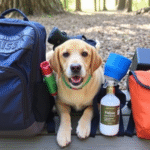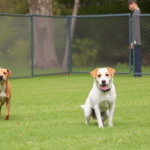Tips for a Peaceful Dog Park Visit with Multiple Dogs
Visiting a dog park can be a delightful experience, especially when you have multiple dogs along for the fun. However, ensuring a peaceful and enjoyable outing requires some planning and foresight. Here are some practical tips to help you manage a harmonious dog park visit with multiple dogs.
Know Your Dogs’ Personalities
Understanding each dog’s behavior is vital. Consider the following:
- Social Tendencies: Some dogs thrive in social settings, while others may prefer solitude. Know which of your dogs are more outgoing and which might need space.
- Play Styles: Different dogs play in various ways. Ensure you’re aware of the play styles of each dog, as more assertive dogs might unintentionally intimidate shy ones.
Choose the Right Time
Timing your visit can greatly influence your experience. Think about these factors:
- Busy Hours: Weekends and late afternoons tend to be busier. Consider visiting early in the morning or during weekdays when fewer dogs may be present.
- Weather Conditions: Keep an eye on the weather. Rainy or extremely hot days might deter other dog owners, leading to a quieter park.
Bring Essential Supplies
Being prepared is key. Make sure to bring along:
- Leashes and Collars: Keep leashes on hand for quick exits or to manage interactions.
- Water and Bowls: Hydration is essential, especially on warmer days. Bring collapsible water bowls for easy access.
- Waste Bags: Always clean up after your dogs to maintain a clean park environment.
Introduce Dogs Slowly
When arriving at the park, take your time to introduce your dogs to each other and to new dogs. Follow these tips:
- Use Visual Cues: Allow your dogs to observe new dogs from a distance before interacting.
- Separate Play Areas: If the park has a designated area for small and large dogs, use it to ensure safety and comfort for all dogs.
Monitor Playtime
While dogs are playing, keep a watchful eye on their interactions. Here are key points to observe:
- Body Language: Look for signs of aggression or discomfort, such as growling, snarling, or tucked tails. If you see anything concerning, intervene gently.
- Breaks Are Important: Give your dogs time to rest. Too much excitement can lead to overstimulation, which can result in conflicts.
Respect Other Dog Owners
Being courteous to other dog owners is just as important. Here are some ways to foster a respectful environment:
- Ask Before Approaching: Always ask if it’s okay to let your dogs meet another dog before allowing them to play.
- Share Your Space: If your dogs are playing well, be mindful of other dog owners who may enter your space. Be open to accommodating them.
Keep Your Dogs Under Control
Using commands can help you maintain control. Techniques to use include:
- Basic Commands: Commands like “sit,” “stay,” and “come” can help manage your dogs effectively.
- Recall Training: Ensure that your dogs respond well to recall, making it easier to call them back when needed.
Plan for Emergencies
Even with the best precautions, emergencies can occur. Be prepared by:
- Knowing Nearby Vet Clinics: Have information on local veterinary offices in case of an emergency.
- Carrying a First-Aid Kit: A basic dog first-aid kit can be handy for minor injuries.
Always remember that the goal of your visit is to enjoy time with your dogs while ensuring everyone’s safety and comfort. For further dog park etiquette and tips, consider visiting AKC’s Dog Park Etiquette. Each visit can be a chance to build positive experiences for your dogs and forge bonds with other dog owners. With the right mindset and preparedness, you can enjoy many peaceful and fun-filled outings at the dog park with your furry companions.
Understanding Dog Body Language in Social Settings
Dogs communicate primarily through body language, especially in social settings like dog parks or during playdates. Understanding these signals can help you interpret your dog’s feelings, leading to better interactions with other dogs and a more enjoyable experience for everyone involved. Here’s a breakdown of common dog body language signals and what they mean.
Common Body Language Signals
By observing your dog’s posture, tail position, and facial expressions, you can gain insights into their emotional state. Here are some key indicators:
- Relaxed Body Posture: When a dog stands or sits with a loose body and wagging tail, they are often comfortable and friendly.
- Tail Wagging: A high-speed wag usually suggests excitement. A wagging tail held low may indicate submission, while a stiff, high-held tail could signal a more dominant attitude.
- Ears Position: Erect ears show curiosity or alertness. Drooping ears may indicate sadness or submission, while pinned-back ears can signal fear or aggression.
- Mouth Movements: A relaxed, open mouth can indicate happiness, whereas a closed mouth with tense jaws might suggest stress or discomfort.
- Eye Contact: Soft eye contact can express affection, while hard stares may convey a challenge or threat.
Reacting to Other Dogs
When multiple dogs are together, body language becomes even more essential for maintaining harmony. Here are signs to watch for with others:
- Play Bow: A dog that bows with their front legs stretched forward and rear elevated is inviting another dog to play.
- Sniffing: This is a social activity that is normal and helps dogs understand one another. However, if one dog heavily dominates the sniffing, it might cause discomfort to the other dog.
- Circling: Dogs that circle each other while sniffing or playing are likely establishing their social dynamics.
- High-Intensity Play: If the play becomes too intense with barking, and growling, it’s wise to step in and separate the dogs before it escalates.
Signs of Stress or Conflict
Recognizing when your dog is feeling stressed or threatened is crucial for ensuring their safety. Look for these signs:
- Raised Hackles: When the fur along a dog’s back stands up, they could be feeling threatened or agitated.
- Avoidance Behaviors: If your dog turns their body away, looks away, or tries to escape a situation, they may be feeling uncomfortable.
- Tail Tucking: A dog that tucks its tail under its body is likely scared or feels submissive.
- Excessive Licking or Yawning: These can be signs of anxiety in dogs and indicate that they need space.
How to Respond to Body Language
Your response to these signals can either ease or exacerbate the situation. Here’s how to react appropriately:
- Stay Calm: Your demeanor can influence your dog’s behavior. Remain relaxed to help soothe your pet.
- Provide Space: If a dog displays signs of discomfort or aggression, give them room to breathe and retreat. Do not force interactions.
- Redirect Behavior: If tension arises, distract your dog with a toy or a command to break the situation.
- Educate Yourself: Learn more about dog body language through resources such as the American Kennel Club or the Very Good Dog.
Understanding your dog’s body language is vital for fostering happy, healthy social interactions. Watching them closely and interpreting their signals can make your time at the dog park enjoyable and safe for both of you.
Remember, each dog is unique, so take the time to learn your canine companion’s personality and body language. This understanding will improve your outings and strengthen your bond. Happy socializing!
Strategies for Managing Dog Behavior at the Park
Visiting a dog park can be a delightful outing for both you and your dog. However, managing dog behavior at the park can sometimes be a challenge, particularly if you’re bringing multiple dogs. Here are some effective strategies to ensure a harmonious and enjoyable experience.
Know Your Dogs’ Temperament
Before heading to the park, take time to understand your dogs’ personalities and how they typically behave around other dogs and people. Some dogs are more social, while others may be more reserved or even anxious in a busy environment. Knowing their tendencies will help you better manage their behavior at the park.
Recalls and Commands
Practice recalls and basic commands such as “sit,” “stay,” or “leave it” before your outing. When your dogs respond well to these commands, it’ll be easier to control their behavior in a stimulating environment. Be ready to use treats or toys as rewards for good behavior, reinforcing the commands even in the park setting.
Socialize Gradually
If you’re introducing a new dog or even one of your own to the park, do it gradually. Start by allowing them to observe the other dogs from a distance. This helps them acclimatize without feeling overwhelmed. Over time, you can decrease the distance as they become comfortable.
Positive Reinforcements
Use positive reinforcement techniques to reward good behavior. When your dog interacts politely with others or follows commands, give them treats or praise. This not only reinforces their good behavior but also builds their confidence in handling social situations.
Keep a Safe Distance
If you notice that your dogs are getting overly excited or aggressive, it’s wise to create space. Move to an area within the park where you can observe other dogs without being too close. This gives them time to calm down and can help manage their excitement.
Monitor Play Styles
Every dog has a different play style. Some may be more dominant, while others are submissive. It’s essential to monitor interactions and step in if play escalates or if one dog seems uncomfortable. Make sure your dogs have appropriate playmates who match their energy levels and play styles.
Structured Activities
Engaging in structured activities can help keep your dogs focused and behaved. Consider bringing along toys like frisbees or balls for interactive play. You can organize mini-games or agility exercises that require your dogs to listen to your commands.
Remove Your Dogs When Necessary
There may be times when removing your dogs from the park is the best option. If there are aggressive dogs present or your dogs are becoming overstimulated, don’t hesitate to take a break. Better to leave early than deal with an uncontrolled situation.
Foster Good Relationships with Other Dog Owners
Building rapport with fellow dog owners enhances the park experience. Establishing friendships can also provide a support network for any issues that arise during your visit. You can share tips and improve your dogs’ social skills together.
Keep Up with Vaccinations
Regular vaccinations are crucial for maintaining your dog’s health, especially in communal environments like dog parks. Ensure that your dogs are up to date on their shots to protect them and others from potential diseases. If you’re looking for vaccination schedules and tips, check American Veterinary Medical Association for guidance.
Stay Patient and Observant
Always remain patient and observant. Dogs communicate their feelings through body language, and being attuned to these cues can help you manage their behavior more effectively. If you’re feeling overwhelmed, take a moment to regroup and reassess your approach.
A peaceful dog park experience requires understanding, preparation, and ongoing management. By employing these strategies, you can create a safe environment for your dogs and enjoy the benefits of socialization, exercise, and fun.
For further resources on managing dog behavior in public spaces, visit American Kennel Club for tips and insights.
Choosing the Right Dog Park for Your Pack
Choosing the right dog park for your canine companions can greatly enhance your dog park experience. The right environment can lead to positive interactions, exercise, and overall happiness for your dogs. Here are essential considerations to ensure you select a park that meets your pack’s needs.
Location and Accessibility
When looking for a dog park, think about its location. A park should be convenient for frequent visits. Check the distance from your home and how easy it is to access. Consider factors like:
- Proximity to busy roads and traffic patterns.
- Adequate parking facilities for hassle-free access.
- Public transport options if you don’t drive.
Size and Layout
The size and layout of the park will impact how well your dogs can play and socialize. A good dog park should have enough space for running and playing. Look for a park that features:
- Separate areas for small and large dogs to ensure safety during playtime.
- Varied terrain, including grassy areas and shaded spots.
- Multiple gates and entrances to prevent escape during busy hours.
Safety Features
Safety is crucial in a dog park, especially with multiple dogs around. Evaluate the park for the following safety aspects:
- Fencing: A secure, high fence should enclose the park to prevent any escape.
- Visibility: Open sightlines allow you to see your dog at all times.
- Markers: Signs that notify pet owners about rules and regulations should be clearly posted.
Dog Behavior and Atmosphere
Every dog park has its vibe. Spend some time observing the dogs currently playing before bringing your own pack. Look for:
- The general temperament of the dogs: Are they friendly, aggressive, or anxious?
- Owner involvement: Are dog owners actively supervising and engaging with their pets?
- The overall atmosphere: Does the community seem welcoming and responsible?
Facilities and Amenities
A great dog park should have various facilities and amenities to create a pleasant experience for both dogs and their owners. Consider the following:
- Water stations for dogs to stay hydrated.
- Shade structures to provide relief from the sun, especially during hot days.
- Benches or picnic tables for owners to relax while their dogs play.
- Trash bins and bags for easy clean-up; cleanliness is key to maintaining a welcoming atmosphere.
Community and Events
Engaging with the local dog community can enhance your dog park experience. Look for areas that host community events, such as:
- Dog training sessions that may help socialize your dogs.
- Fundraisers or dog fairs to meet other dog owners.
- Regular meet-ups for various dog breeds, allowing your pets to interact with different personalities.
Online Resources and Reviews
Before finalizing your choice, utilize online resources to gather reviews and ratings of local dog parks. Websites like Rover or BringFido offer valuable insights and ratings from pet owners who have visited specific parks. Check for:
- Recent visitor testimonials and their experiences.
- Photos shared by dog owners that showcase the park’s amenities.
Visiting the right dog park can transform your pack’s outing from a simple walk into an exciting adventure. By considering location, safety, community, and facilities, you can select a park that ensures enjoyable and safe experiences for your dogs. Your furry friends will thank you with wagging tails and happy barks!
The Importance of Socialization for Multiple Dogs
Socialization is a crucial aspect of dog ownership, especially for those with multiple dogs. Ensuring that your pets interact well with each other and with other dogs can significantly enhance their behavior, reduce anxiety, and improve their overall quality of life. Understanding the importance of socialization can help you establish a harmonious environment at home and during outings.
Benefits of Socialization
When multiple dogs are socialized properly, the benefits are numerous:
- Improved Behavior: Well-socialized dogs usually exhibit better manners and are less likely to display aggressive or anxious behaviors.
- Enhanced Communication: Dogs learn how to communicate effectively with each other, understanding body language and vocalizations, which decreases the likelihood of misunderstandings.
- Greater Confidence: Dogs that are regularly socialized tend to be more confident not just around other dogs but also in various environments.
- Reduced Aggression: Regular interactions reduce fear-based aggression. This is especially crucial for multiple dogs living in a single household.
- Stronger Bonds: Socialization can strengthen the bonds between dogs, making for a more peaceful living situation.
Effective Socialization Techniques
To successfully socialize multiple dogs, consider implementing the following strategies:
Start Early
For puppies, early socialization is key. Take them to different places, introduce them to various dogs, and expose them to new experiences. This helps them grow into well-adjusted adults.
Controlled Introductions
When introducing new dogs to your pack, do it in a controlled setting. Use leashes initially, watch their body language closely, and let them engage at their own pace. Manage their interactions to prevent any overwhelming situations.
Group Training Classes
Enroll your dogs in group training sessions. This provides a structured environment where they can socialize while learning obedience. Training classes usually offer a distraction-free space where dogs can learn basic commands and interact with each other positively.
Designate Playdates
Having regular playdates with other dogs can enhance your dogs’ social skills. Choose familiar and friendly dogs, and keep the sessions short but frequent to avoid overwhelming them.
Recognizing Signs of Stress
Not all dogs are social butterflies. It is essential to recognize when a dog is stressed or anxious. Look for these signs:
| Signs of Stress | Behavioral Indicators |
|---|---|
| Excessive Barking | Dog may be anxious and trying to communicate discomfort. |
| Avoidance | Dog tries to hide or withdraw from social interaction. |
| Tail Tucked | Sign of fear or submission; the dog may not feel secure. |
| Body Freezing | The dog becomes stiff, signaling discomfort or fear. |
If you notice these signs, take a step back and allow your dog some space. Gradually reintroduce them to social settings while rewarding calm behavior.
Balancing Individual Attention
When you have multiple dogs, it’s crucial not to neglect individual attention. Spend time with each dog one-on-one, so they feel valued and secure. This individual bond enhances their overall behavior and allows you to understand each dog’s specific needs.
Resources for Dog Socialization
Consider visiting reputable websites for further insights into dog socialization, such as American Kennel Club and Humane Society. They provide valuable resources on dog training techniques and socialization strategies tailored for multiple dogs.
Socializing multiple dogs is essential for harmonious living and happy pets. By engaging in structured socialization practices and staying attuned to each dog’s comfort levels, you foster a peaceful environment and promote positive interactions for all your furry friends.
Preparing Your Dogs for a Successful Park Visit
Taking your dogs to the park can be a fantastic way for them to socialize and get some exercise. However, preparing your furry friends properly is essential for a successful visit. By ensuring your dogs are well-prepared, you create a safer and more enjoyable experience for everyone involved. Here are several tips to get you started.
Know Your Dogs’ Temperaments
Before heading to the park, it’s crucial to understand each dog’s personality. Not every dog is comfortable in a busy environment. Pay attention to their behavior when interacting with other dogs and people. Consider the following:
- If one of your dogs is shy, ensure they have the option to retreat or take breaks.
- A dog that tends to be overly energetic might need some extra exercise before the trip.
- Encouraging calmness through training can be beneficial for more excitable dogs.
Socialize in a Controlled Environment
Prior to visiting the park, allow your dogs to socialize in a controlled setting. This could be in your backyard or a friend’s home. Make sure they are comfortable around other dogs before introducing them to a larger group. You may want to set up short playdates to help them acclimate to new environments. This can foster confidence in your dogs and improve their behavior at the park.
Utilize Basic Training Commands
Ensuring your dogs are well-trained with essential commands can improve safety and enjoyment during your visit. Commands like “sit,” “stay,” and “come” create a calmer atmosphere. Consider reinforcing training sessions before your park trip. Here’s how to implement training effectively:
- Practice commands in short, frequent sessions leading up to the park visit.
- Use treats or toys as rewards to encourage positive behavior.
- Make training a part of your routine to maintain their skills.
Pack Essential Items
Bringing the right supplies can make your visit more enjoyable. Here’s a list of essentials you should consider:
- Leash and harness for each dog
- Water and a collapsible bowl to keep them hydrated
- Portable poop bags for clean-up
- Dog toys to keep them entertained
- A first-aid kit for minor emergencies
Choose the Right Time for Your Visit
Timing can greatly influence your experience at the dog park. Visiting during off-peak hours can help avoid overcrowded situations. Early mornings or weekdays are often less busy. Look for the following signs that indicate an ideal time:
- Fewer dogs present in the park
- Calm atmosphere without excessive noise or chaos
- Weather conditions that are comfortable for both you and your dogs
Monitor Your Dogs at All Times
Once you arrive, keep a vigilant eye on your dogs. This ensures they are safe and can help manage their interactions with others. Here are a few tips to keep in mind while monitoring:
- Stay alert to any signs of aggression or discomfort in your dogs.
- Be prepared to intervene if play becomes too rough.
- Encourage positive dog-to-dog interactions through careful observation.
Be Respectful of Other Dogs and Owners
While at the park, remember that you’re sharing the space with other dog owners. Practices such as keeping your dogs close by when another dog approaches can create a respectful environment. Consider the following respectful behaviors:
- Ask permission before letting your dog approach another person’s dog.
- Remove your dog from the situation if they display aggression.
- Clean up after your dogs immediately to maintain a tidy environment.
For more insights on preparing for dog park visits, consider exploring resources like the American Kennel Club.
All of these elements contribute to a successful park visit with multiple dogs. By understanding your dogs, training them properly, and being respectful to others, your day in the park can become a wonderful routine for you and your pets.
Engaging Activities for Dogs at the Park
Taking your dog to the park is an excellent way to provide them with exercise, socialization, and fun. To make the most of your visit, engaging your dog in various activities can turn a simple trip into an adventurous day. Here are some delightful activities you can enjoy together.
Interactive Games
Playing interactive games is a great way to bond with your dog while keeping them mentally stimulated. Consider these activities:
- Fetch: A classic game everyone knows. Use different toys or balls to keep your dog interested. Vary the distance and direction to challenge them.
- Hide and Seek: Hide somewhere in the park and call your dog. Reward them with treats when they find you. This game taps into their natural instincts and enhances their problem-solving skills.
- Frisbee: If your dog loves to run, frisbee can be an exciting way to engage. Choose a soft frisbee to avoid injuries, and vary your throws to keep them on their paws.
- Tug-of-War: Bring a durable rope or chew toy and enjoy a fun session of tug-of-war. Just ensure to establish rules to prevent over-excitement or aggression.
Agility Training
Many parks have areas designated for agility training or you can set up your own mini-course. This activity is excellent for exercise and mental stimulation. Consider incorporating the following elements:
- Jump Obstacles: Use small jumps or poles for your dog to navigate. Increase the difficulty as they get better.
- Tunnels: If you have access to agility tunnels, encourage your dog to run through them. This can be a fun way to build confidence.
- Weave Poles: Set up cones or sticks in a line for your dog to weave in and out of them. It’s a great way to improve their coordination.
Water Activities
If your dog enjoys water, engaging in water-related play can be refreshing on a hot day. Here are some ideas:
- Swimming: If there’s a dog-friendly lake or pool, take your pup for a swim. Bring floating toys for added fun!
- Water Fetch: Instead of a regular fetch game, toss a water-safe toy into the water and let them retrieve it.
- Paddling Pools: Fill a kiddie pool with some water and let your dog splash around. It can be a great way for them to cool down.
Socialization Opportunities
Dog parks provide excellent opportunity for socialization. Here are some tips to make the most of it:
- Playdates: Arrange meetups with friends who have dogs. Watching their interaction can offer insightful behavior observations.
- Group Activities: Participate in organized playgroups at the park. These gatherings can help build confidence and teach proper dog etiquette.
- Networking: Connect with other dog owners. Sharing experiences and tips can enhance your dog’s social skills.
Relaxation Time
After all the running and playing, don’t forget the importance of relaxation. Here are suggestions for calming activities:
- Leash Walks: Take a leisurely stroll around the park to wind down. It provides a great opportunity for sniffing around and enjoying the surroundings.
- Picnic Break: Bring a picnic blanket and enjoy a snack alongside your pup. Sharing a calm moment can strengthen your bond.
- Training Sessions: Incorporate training into your downtime. This can help the dog learn new commands in a relaxed environment.
Engaging your dog with various activities at the park can not only keep them healthy but foster a strong bond between you two. To learn more about enriching your dog’s life, check out resources from AKC and ASPCA.
Key Takeaway:
Visiting a dog park with multiple dogs can be a rewarding experience for both you and your furry companions, but it requires careful preparation and understanding. The key takeaway from the article revolves around a few crucial aspects that ensure a peaceful and enjoyable dog park visit.
Firstly, understanding the body language of dogs is essential. Dogs communicate through their postures, facial expressions, and vocalizations. By learning to read these signals, you can anticipate how your dogs—and others—may react in social situations. For instance, if a dog is showing signs of aggression or anxiety, such as a stiff body or a low growl, you’ll be better equipped to remove your dog from a potentially stressful encounter.
Next, managing your dogs’ behaviors is critical. Bring along treats, toys, or engaging activities that can serve as positive distractions during playtime. This variety can keep your pack occupied and reduce the likelihood of squabbles. Also, keeping an eye on their interactions will help you step in when necessary to prevent fights or excessive roughhousing.
Choosing the right dog park makes a significant difference too. Some parks may have dedicated areas for smaller or less active breeds, which can be helpful if you have a diverse group. Select a park that has ample space for your dogs to run freely, and take notice of the park’s layout and the behavior of other dogs already present.
Socialization is another vital element. Regular visits to the dog park can help your dogs develop better social skills, making them more comfortable in various situations around other dogs. prepare your dogs ahead of your visit: ensuring they are well-exercised before arriving and familiarizing them with commands will lead to a more harmonious experience.
With these points in mind, a thoughtful approach not only helps in managing multiple dogs effectively but also enriches their lives, allowing them to socialize and play in a safe environment, ultimately leading to a fulfilling dog park visit for you and your dogs.
Conclusion
A peaceful dog park visit with multiple dogs can greatly enhance the social experience for both pets and owners alike. Understanding the subtle cues of dog body language allows you to gauge whether your dogs are comfortable or need a break. This awareness can help prevent conflicts and ensure a harmonious atmosphere.
Employing effective strategies for managing dog behavior, such as setting boundaries and redirecting energy, will keep your visit enjoyable for everyone involved. Choosing the right dog park is equally essential; look for spaces that cater to various sizes and temperaments to accommodate your pack’s dynamic.
Socialization plays a vital role in developing well-rounded canines. Regular visits not only boost your dogs’ confidence but also foster positive interactions with other dogs. Preparing your dogs ahead of time by reinforcing basic commands and practice can make the experience smoother and more enjoyable.
Don’t forget to incorporate engaging activities during your park visit. Interactive play, agility courses, or even simple fetch games can keep your dogs entertained and stimulate their minds, reducing the likelihood of unwanted behaviors.
By following these guidelines, you create a safer and more enjoyable environment for yourself and your furry companions. With a little preparation and understanding, your trips to the dog park can be a rewarding experience, enriching the bond you have with your dogs.






Leave a Reply